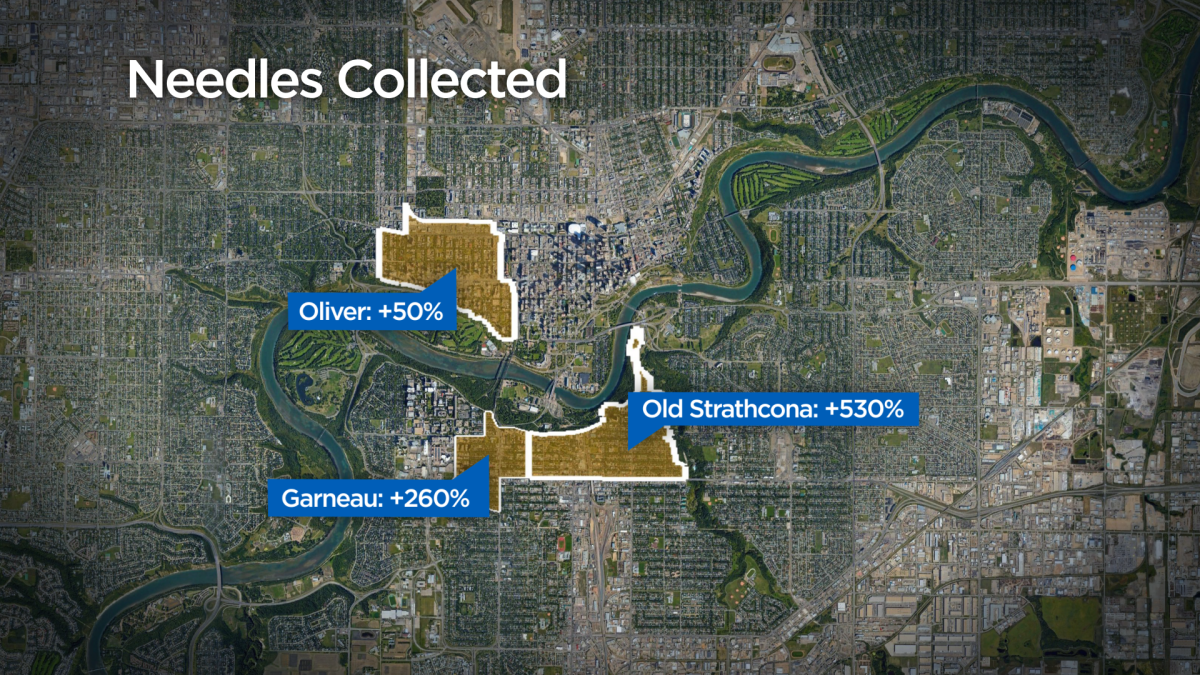The overall number of needles reported in the city of Edmonton dropped substantially in 2018, and those who are responsible for supervised consumption sites said they believe those sites are assisting in the decline.

“I’m pleased,” said Marliss Taylor, director of Streetworks.
“I don’t think the data gives us an exact causal thing, but I do think they have contributed. I think it’s a very good thing. I’m very happy to see, in most cases, we have seen decreases in needles on the ground.”
READ MORE: Overwhelming demand at Edmonton supervised consumption sites in first 6 months
Global News analyzed maps and data from the City of Edmonton showing reports of needles collected on public property in each neighbourhood in the city. Numbers from the nine months after the first sites — at Boyle Street Community Services and George Spady Centre — opened in March 2018 were compared to the same time period in 2017.
Another site inside the Boyle McCauley Health Centre opened in November 2018 while a fourth site inside the Royal Alexandra Hospital is only open to patients.
RELATED: Supervised-injection service locations for drug users announced in Edmonton
The data reveals there were 7,455 reports of needles across the city from April to December 2017 while there were 3,845 reports of needles during the same period in 2018.
WATCH BELOW: Investigative reporter Julia Wong joins Jennifer Crosby to talk about Edmonton’s supervised consumption sites, the number of needles in the areas, and the challenges she faced getting the information.

Taylor said supervised consumption sites can offer different services for drug users that may be contributing to the decrease.
“I think that what supervised consumption services do is they decrease, for a lot of people, a chaotic type of drug use,” she said. “We do know when people use supervised consumption services, they leave their needles in there, so that’s a very good thing.
“What supervised consumption does, is it gives us some time with someone when they’re not in withdrawal, where we’ve asked them to stay and we can start working on some of the things they think will help them get to a better place.”
Most neighbourhoods directly around the supervised consumption sites saw decreases in the number of needles reported of between 30 and 90 per cent in 2018. Central McDougall saw the opposite effect with a more than 200 per cent increase compared to 2017.

The city said there is a reason the maps were made using the neighbourhood where a needle was found, as opposed to anything more specific.
“Unfortunately, there is stigma associated with needle use and debris. The City is mindful that providing specific locations of where needles are collected can impact people – the reputation of an individual’s business, street or home. As a result, we have developed these maps using a neighbourhood lens,” said city spokesperson Adrienne Cloutier.
Data leads to more needle boxes
Taylor said it is hard to make connections between the supervised consumption sites and neighbourhoods farther away from the downtown core that are seeing increases.
“We don’t work in the areas there. I think that people who use substances are living all over the city. At different times, different people are in different neighbourhoods,” she said, adding sometimes there are reports of needles associated with medical issues.
“I think that that’s more episodic and more one-offs. We would have to look at the trends over time. If it turned out that there was an ongoing issue, then probably we would try and see if we could make any connections in that neighbourhood and try and figure out what’s going on.”
View some highlights of the data in the chart below:
Don Belanger, head of Capital City Clean Up for the City of Edmonton, said there could be several reasons for the increases outside of downtown.
“One is that the population that’s injecting is more mobile and able to move around,” he said. “Two, that there is some instances where multiple needles were dropped in one location, which were counted as needles, it might have been one call. The third thing is, we’re seeing a lot more traffic back and forth between the downtown and across the river.”
Belanger said that, based on the data, there are plans to install up to three needle boxes in Old Strathcona within the next six weeks. That neighbourhood saw a 530 per cent increase of needles reported between April to December 2017 and the same period in 2018.
He said there are plans to have up to 25 needle boxes in the city by the end of 2019; there are currently 13.
More needle calls to 311
The city launched a public awareness campaign for discarded needles in the fall. Both Taylor and Belanger said that may have played a role in residents being more vigilant towards needles and calling 311.
Belanger said the city received more needle calls to 311 in 2018 compared to 2017.
“The use of 311, to have the public direct any needles found on public property to us, is incredibly important,” he said. “As long as they’re able to make that call, we’ll be able to come out and pick it up.”
Global News initially filed a Freedom Of Information (FOI) request for maps showing where the city was collecting needles. The maps released by the city were Google Map screenshots and the FOI office said it could not release anything more specific or interactive for privacy reasons. Global News, along with other media, repeatedly asked for numbers and more detail. A few weeks later, the city quietly released the neighbourhood-specific maps, saying that data should be shared with the public.
Coming up on Thursday: Global News has reactions from two neighbourhoods who have had different experiences since the supervised consumption sites opened.
Have a tip about this story? Email reporter Julia Wong at julia.wong@globalnews.ca











Comments